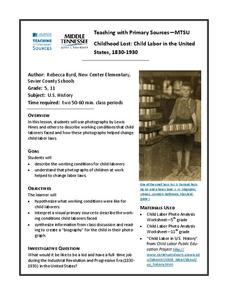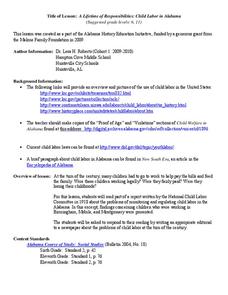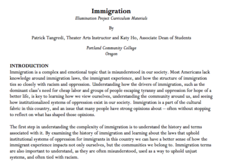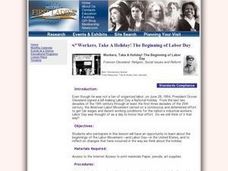Curated OER
Childhood Lost: Child Labor in the United States, 1830-1930
Working in groups, middle and high schoolers describe and discuss photographs depicting working conditions experienced by child laborers in the 19th century. They then write a persuasive paragraph supporting an amendment to regulate the...
Curated OER
Child Labor in Maryland: An Historical Investigation
Tenth graders, after reading two excerpts about contemporary child labor situations, discuss two broad questions in detail along with the industrial boom following the Civil War conditions in the United States. They investigate how the...
Library of Congress
Child Labor in America
Students investigate child labor during the Great Depression. In this US policy activity, students evaluate multiple layers of the social, economic, and political affects of policy during the Great Depression. Students will engage in 5...
PBS
Women's History: Glass Windows; Glass Ceilings
Discover stories about women's history in beautiful stained glass windows. The second in a three-part series teaches scholars about a famous artistic style of stained glass windows and the influential women that used art to impact...
Alabama Department of Archives and History
A Lifetime of Responsibilities: Child Labor in Alabama
Imagine children working long hours in factories, coal mines, and in the fields. Class members examine a series of pictures and read about early attempts to regulate child labor and current child labor laws.
School Improvement in Maryland
Are These Human Right Violations?
Using the Declaration of Human Rights and the United States Constitution as reference tools, class members examine 14 scenarios to decide if the situation represents a violation of human rights, and if these same rights...
Smithsonian Institution
Art to Zoo: Life in the Promised Land: African-American Migrants in Northern Cities, 1916-1940
This is a fantastic resource designed for learners to envision what it was like for the three million African-Americans who migrated to urban industrial centers of the northern United States between 1910 and 1940. After reading a...
Curated OER
Child Labor Laws in the United States and the State of Nebraska
Students examine child labor laws. In this social justice instructional activity, students compare and contrast child labor laws of the United States and the state of Nebraska. Students research primary sources and complete the included...
Curated OER
Prosperity and Challenges
Learners watch a slideshow about the technological advances in agriculture. After viewing, they complete an index card about one aspect of the slideshow. In groups, they create a cause and effect timeline in which they identify specific...
Curated OER
Immigration Illumination Project Curriculum Materials
Gain an understanding of the complex topic of immigration with a collection of resources. Class members engage in a series of activities designed to give them insight into the factors that influence immigration policies and the effects...
Curated OER
United States - Japanese Relations In Post World War II Era
Ninth graders explore the relationship between the United States and Japan. In groups, classmates research the treatment of Koreans and Americans as prisoners of war. Pupils examine the effect of politics and agreements during the war....
Pulitzer Center
China's Rising Labor Movement
Young historians will explore the complex causes and effects of industrialization in China by perusing the numerous articles included in this webpage. Throughout the resource, there are many writing and discussion prompts to help direct...
University of Arkansas
Promises Denied
"Promises Denied," the second instructional activity in a unit that asks learners to consider the responsibilities individuals have to uphold human rights, looks at documents that illustrate the difficulty the US has had trying to live...
Center for History Education
To What Extent Were Women's Contributions to World War II Industries Valued?
Women rose to the challenge when the nation's war effort called them—but were sent home when the GIs came back from World War II. Young historians consider whether the United States valued women's contributions during the war using a...
Curated OER
Working for a Living: Child Labor Laws
Young scholars research the working conditions in the late 1800's and the evolution of child labor laws. They discuss how the laws affect them today and if they are fair. They write a paper summarizing the laws and the view of the laws.
Curated OER
Immigration to the United States
Students examine the reasons why people immigrated to the United States. Using maps and charts, they analyze population movements and religious affiliations. They discover how the United States became a lesser Protestant country.
Curated OER
Federal Holidays
Third graders complete various activities pertaining to Martin Luther King Jr. Day, Presidents' Day, Memorial Day, Labor Day, Columbus Day, and Veteran's Day. They conduct research and complete writing and art activities on the...
National First Ladies' Library
Workers, Take a Holiday! the Beginning of Labor Day
When your upper elementary class returns in the fall, have them identify and define the beginnings of the labor movement and Labor Day in the United States. They thoughtfully reflect on changes that have occurred in the way we think...
Curated OER
Cotton And Child Labor
Eleventh graders investigate the practice of child labor as found in the history of the United States. The teacher reads the class a story from the year of 1914. This creates context for the lesson and then students answer teacher...
Curated OER
Freedom Voices: Abolition and Suffrage in the United States
Learners explore abolition and suffrage in the United States.
Curated OER
Mexican American Labor in the U.S.
Ninth graders examine how the United States historically shifts policies toward Mexican and Mexican American laborers to acquire cheap, temporary labor. In this US History lesson, 9th graders research the history of immigration from...
Curated OER
Labor History in the United States
Eleventh graders read several articles regarding ethics and ethical behavior. They analyze the reasons for tragedies and circumstances surrounding the relationships between labor and owners. In small groups, 11th graders write a report...
Curated OER
Leaders, Laborers, and Other Perspectives of World War II
How did the women in France feel about their country’s involvement in World War II? Class groups are assigned a country involved in WWII, and individuals within the group adopt the point of view of leaders, laborers, businessmen, women,...
Curated OER
Oral History of World War II
Students research how citizens from the United States respond to the onset, duration and aftermath of World War II. They view clips from the movie "Swing Shift" and discuss the roles of civilians, minorities and military personnel. They...























